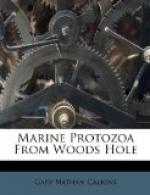Pleuronema chrysalis Ehr., sp. Fig. 40.
Synonyms: Pleuronema crassa Dujardin ’41;
P. marina Duj. ’41;
Fabre-Domergue ’85; P. coronata Kent
’81; Paramoecium chrysalis
Ehr. ’38; Lembadion orale G. & R. ’88;
Histiobalantium agile
Stokes ’85, ’88.
The body is ovoid, slightly flattened, rounded at both ends, the anterior end sharper than the posterior. The ventral surface is almost entirely taken up by a peristome which extends from the anterior end posteriorly three-quarters of the body length. The posterior end of the peristome is straight, the left curved, following the depressed portion. The body is covered with fine cilia in longitudinal lines, except on the peristome. The mouth is small and situated in the hollow of the peristome near the left border. On the left peristome edge is a large undulating membrane. It begins near the anterior end of the body and increases in height posteriorly following the peristome edge around on the right side. This posterior bend of the membrane causes the appearance of a full sail, so often seen. It can be entirely withdrawn and folded together in the peristome. On the right edge of the peristome are large, powerful cilia. The contractile vacuole is central and dorsal; the macronucleus is in the anterior half of the body, with one attached micronucleus. Food consists of bacteria. Not very common. Fresh and salt water. It often remains quiet, with membrane and cilia outstretched, as though dead, but suddenly gives a spring and is gone.
[Illustration: Fig. 40.—Pleuronema chrysalis.]
Pleuronema setigera, n. sp. Fig. 41.




